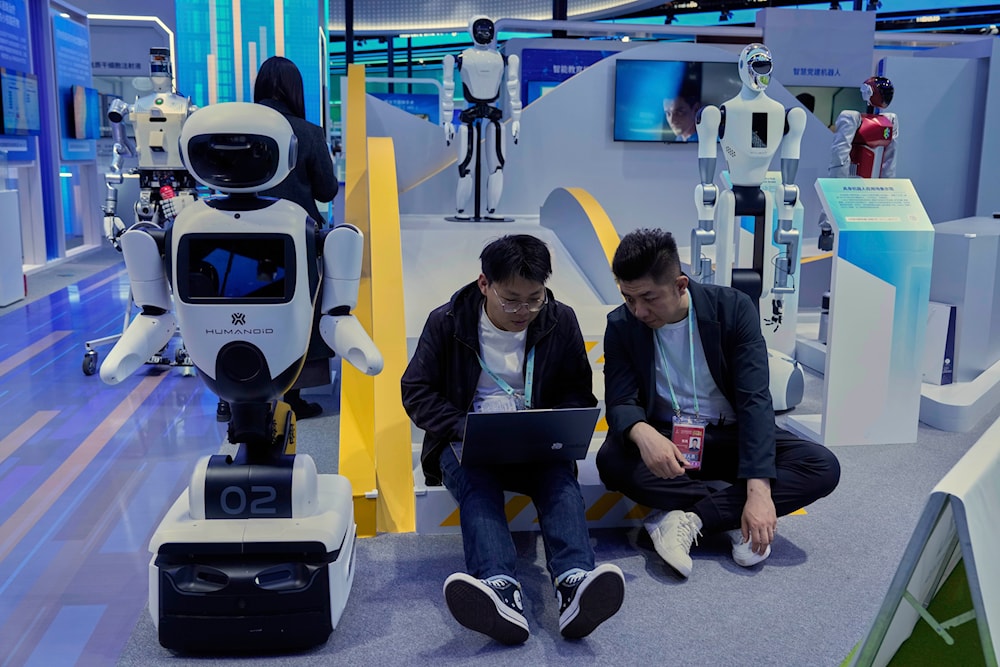Why the US is losing the robot race to China
This in-depth report, based on Business Insider's exclusive coverage, explores the escalating race for dominance in humanoid robotics.
-

Two men work near humanoid robots displayed during the Zhongguancun Forum at the Zhongguancun International Innovation Center in Beijing, China, on Friday, March 28, 2025 (AP)
As US President Donald Trump stood at the White House podium in January, declaring a $500 billion investment into the so-called Stargate Project — “the largest AI infrastructure project by far in history” — he cast the initiative as a landmark effort to secure American leadership in the artificial intelligence era. Designed to power models like OpenAI’s ChatGPT and Anthropic’s Claude, the project promised to keep the US at the forefront of the global tech race. “It’s all taking place right here in America,” Trump assured.
But as Business Insider reports, while Washington channels its resources into AI’s digital mind, it may be overlooking an equally critical — and rapidly unfolding — frontier: AI’s physical form. In the race to dominate the humanoid robotics sector, China is not just gaining ground. It is already setting the pace.
From patent filings to factory floors, Chinese firms are outproducing, outspending, and outmaneuvering their US counterparts in what experts say could spark an industrial shift rivaling the original revolution. As one analyst put it, without a serious course correction, the United States may find itself on the losing end of the most transformative labor and manufacturing upheaval of the 21st century.
America’s AI Ambitions face a mechanical setback as China surges ahead
Barely a week after President Trump’s high-profile AI announcement, China offered a striking, if understated, reply. As Business Insider reports, the 2025 Spring Festival Gala — one of the world’s most-watched television events — featured a mesmerizing performance by 16 AI-powered humanoid robots created by the Chinese robotics firm Unitree. Sharing the stage with human dancers, the robots moved in perfect synchrony to traditional folk music, delivering more than just entertainment. The performance, as per the piece, sent a clear and calculated signal: while the US focuses on building AI's brain, China is positioning itself to lead the race for its body.
JPMorgan estimates the market potential for humanoid robots at 5 billion units in the coming years. Elon Musk is even more bullish, forecasting that by 2040, humanoids could outnumber people. “Optimus will be the biggest product of all time by far,” Musk recently declared of Tesla’s humanoid robot. “Nothing will even be close. I think it will be 10 times bigger than the next biggest product ever made.”
Whether as factory workers, household assistants, or restaurant staff, these robots are expected to reshape labor and society. And by all accounts, China is positioning itself as the chief architect of that transformation.
Wider context
Over the past five years, Chinese firms have filed 5,590 patents related to humanoid robots — nearly four times the number registered in the United States. That figure even eclipses the combined total of the next 19 countries, according to Morgan Stanley. In 2024 alone, China introduced 35 humanoid models to the market, accounting for two-thirds of the global total. North American firms, by contrast, launched just eight.
A recent report from research firm SemiAnalysis, titled America Is Missing the New Labor Economy, warns of dire consequences. “We are in the early precipice of a nonlinear transformation in industrial society,” the authors wrote. And unless the US dramatically expands its robotics capabilities, “an existential threat to the US” looms — one in which it is “outcompeted in all capacities.”
William Matthews, a senior research fellow at Chatham House, puts it more starkly: “What you're looking at potentially is an Industrial Revolution-like shift in the balance of power.”
According to Matthews, China’s edge lies not just in R&D but in its unmatched manufacturing ecosystem and government backing. “China has positioned itself quite effectively to be set to dominate the robotics sector and the robotics supply chain,” he said.
Indeed, supply chain control may be the defining factor. Although the US leads in AI brains — with 13 of the 22 major AI firms developing humanoid “brains” based in America — that portion only accounts for around 4% of the cost of a humanoid robot. The rest lies in building the physical form — motors, actuators, sensors, and components that bring AI to life.
And in that arena, China reigns supreme. More than half of the companies involved in building robot body parts are headquartered in China, compared to just 17 in the US. China also monopolizes production of key components, such as planetary roller screws — advanced actuators essential for modern humanoids.
The world scrambles as China leads robotics revolution
According to Business Insider, this growing imbalance carries weighty consequences. The Trump administration’s steep tariffs on Chinese imports — now reaching 145% — are already driving up production costs for US companies hoping to compete in the humanoid robotics market. While America retains a lead in AI software development, the report cautions that the decisive battle over automation may ultimately be won in Chinese factories, not Silicon Valley.
Some signs of momentum are emerging. Companies like logistics powerhouse GXO and entertainment giant Disney have begun investing in humanoid technologies. Yet analysts say these moves remain modest relative to the scale of China's advances. “Unless serious and massive action is taken soon in the United States, in Europe, in Japan and South Korea,” warns Chatham House fellow William Matthews, “it’ll be very hard to compete with China in the long run.”
As things stand, Matthews concludes, China is setting the pace — and the rest of the world is struggling to catch up.

 5 Min Read
5 Min Read








